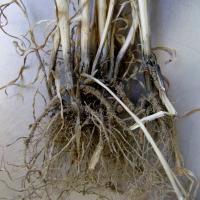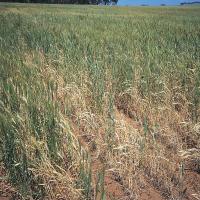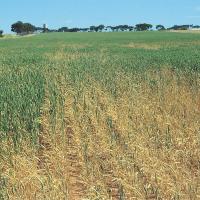Diagnosing take-all in cereals
A fungal root disease that can cause severe yield losses of wheat and barley especially in medium- to high-rainfall areas.
What to look for
- Patches (up to several metres in diameter and with indistinct and irregular edges) of white coloured tillers and heads containing shrivelled or no grain.
- Affected plants can be individuals scattered among healthy plants or entire populations of plants over a large area.
- Control First obvious signs of infection are seen after flowering with the development of white heads.
- Roots of affected plants are blackened and brittle and break easily and are black to the core not just on outer surface.
- Severely affected plants can also have blackened crowns and lower stems.
Plant
What else could it be
| Condition | Similarities | Differences |
|---|---|---|
| Diagnosing crown rot of cereals | White heads | Crown rot causes honey-coloured roots rather than black |
| Diagnosing stem and head frost damage in cereals | White heads | Take-all has blackened roots and crowns |
| Diagnosing copper deficiency in wheat | White heads | Take-all has blackened roots and crowns |
| Diagnosing spring drought in wheat and barley | White heads | Take-all has blackened roots and crowns |
| Diagnosing molybdenum deficiency in cereals | White heads | Take-all has blackened roots and crowns |
Where did it come from?
- The fungus that causes take-all survives over summer on residues of cereals and grasses.
- Take-all is most prevalent in the wetter western and southern areas of the wheatbelt.
- Take-all risk is highest after grassy pastures or wheat or barley.
Management strategies
- By far the most effective method of reducing take-all is to remove grasses in the year before the crop with a grass-free pasture or 'break' crop.
- Seed, fertiliser or in-furrow applied fungicides are registered for take-all control.
- Acidifying fertilisers can slightly reduce disease severity (take-all severity may increase following liming).
- Control volunteer grasses and cereals.
- Delay sowing following the opening rains by implementing a short chemical fallow.
See also
Further information
Where to go for expert help
Page last updated: Friday, 17 April 2015 - 2:24pm





